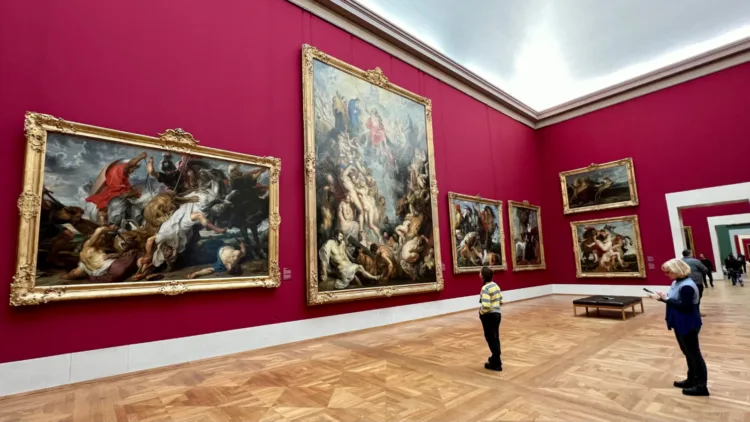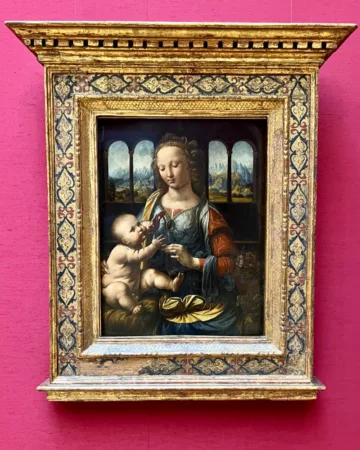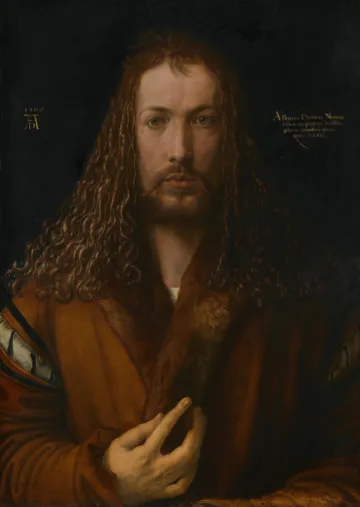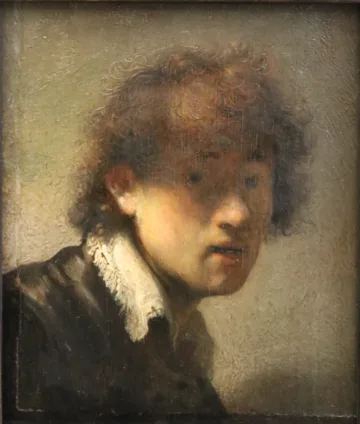Visit the Alte Pinakothek in Munich to see one of the best collections of Old Master paintings in the world, including a top self-portrait by Albrecht Dürer, the largest Peter Paul Rubens collection, an early Leonardo da Vinci painting, and representative works by all major artists and European art genres from the 1300s to the 19th century.

The Alte Pinakothek in Munich is home to the state of Bavaria’s vast collection of Old Master paintings from the late Middle Ages, Renaissance, Baroque, and Rococo periods. The Early German paintings collection is considered the most comprehensive in the world, while the Dutch primitives include many important works. The Dutch Golden Age is well represented while the Flemish Baroque is crowned by 72 paintings by Peter Paul Rubens. The Italian gallery includes the only Leonardo da Vinci in Germany, several works by Raphael, and further paintings by all major artists from Giotto to Titian and Canaletto. The French and Spanish collections are smaller but include works by major artists. The best-known painting in the Alte Pinakothek is Self-Portrait with Fur-Trimmed Robe by Albrecht Dürer. Admission is covered by the Munich City Pass or book a private tour.
Alte Pinakothek Art Museum in Munich

The Pinakothek in Munich was built to house the vast collection of paintings owned by the Wittelsbach family, which ruled Bavaria (and other parts of Germany and Europe, from the 11th century to 1918). The neo-Renaissance building, designed by Leo van Klenze, opened in 1826 as the largest museum in the world. It was praised for its large windows and skylights that allowed natural light to stream into the exhibition halls and strongly influenced museum design in the 19th century.
The name Alte Pinakothek (old picture gallery) refers to the age of the building. The Neue Pinakothek (new picture gallery) opened across the street in 1859 as the first museum in Europe for contemporary art. It is coincidental that the art in the Alte Pinakothek (1300s to late 1800s) is also older than the 19th-century art usually in the Neue Pinakothek. The Pinakothek der Moderne, which opened in 2002, appropriately displays modern art — in four museums: Art (Kunst), Architecture (Architektur), Design (Design), and Works on Paper (Graphik).
The Alte Pinakothek was severely damaged during the Second World War but most of the art was in safe storage. In the 1950s, the old building was repaired rather than restored. The uncovered brick areas on the exterior of the museum serve as a permanent reminder of the destruction of war. The Neue Pinakothek building burnt down in 1944 and only reopened in 1981. It is currently being renovated — until its reopening (after 2029), some of the 19th-century highlights are on display in the Alte Pinakothek and other museums.
Permanent Collections in the Alte Pinakothek in Munich
The permanent collection of the Alte Pinakothek is one of the best collections of Old Master paintings in the world. The various Wittelbachs collected extensively and later acquisitions ensured a balanced collection that covers all main artists and genres of European paintings from the 13th to the 18th century.
The main collections of the Alte Pinakothek include:
- Old German paintings (1300-1550)
- German paintings (1550-1780)
- Early Netherlandish paintings (1300-1550)
- Dutch paintings (1550-1780)
- Flemish paintings (1550-1780)
- Italian paintings (1300-1780)
- French paintings (1400-1780)
- Spanish paintings (1500-1780)
Currently, some 19th-century paintings are also on display in the Alte Pinakothek while the Neue Pinakothek is being renovated (until 2029).
Visiting the Alte Pinakothek in Munich
Nearly two centuries on, the Alte Pinakothek in München is still a big building, which allows for over 700 paintings to be on permanent display. The current permanent exhibition does not strictly follow chronology or geography and places masterpieces from different eras and genres together for easier comparison.
The main exhibition halls are on the upper floor. The larger gallery halls (Saal) use Roman numerals while the smaller rooms (cabinets) are numbered normally. Numbers are repeated on the upper (OG / Obergeschoss) and ground floors (EG / Erdgeschoss).
Top Tip: If visiting first thing on a busy day, head straight to Gallery I on the upper floor. Albrecht Dürer’s Self-portrait is not only the most popular work in the museum, but the Alte Pinakothek actively encourages selfie-taking here. Gallery I currently also has several very popular 19th-century painters on display including paintings by Caspar David Friedrich and Johan Christian Dahl.
Old Masters Highlights in the Neue Pinakothek
The collection of German Old Masters in the Neue Pinakothek in Munich competes with the Gemäldegalerie in Berlin and the Germanisches National Museum in Nuremberg for being the most impressive in Germany. The Early German masters’ collection is considered the most comprehensive in the world, while the Dutch primitives include some key works. The Dutch Golden Age is well represented while the Flemish Baroque is crowned by 72 paintings by Peter Paul Rubens. The Italian collection includes works by all major artists from Giotto to Canaletto and the only Da Vinci in Germany.
Some of the top works on display in the Alte Pinakothek include:
- Albrecht Dürer: Self-Portrait with Fur-Trimmed Robe (Selbstbildnis im Pelzrock), 1500
- Rogier van der Weyden: Saint Columba altarpiece (Columba Dreikönigsaltar), c.1455
- Albrecht Altdorfer: The Battle of Alexander at Issus (Alexanderschlacht), 1529
- Leonardo da Vinci: Madonna of the Carnation (Madonna mit der Nelke), c. 1478-80
- Raphael: The Holy Family (Die hl. Familie aus dem Hause Canigiani), c. 1505
- Peter Paul Rubens: The Large Last Judgment (Das Große Jüngste Gericht), 1617
- Pieter Bruegel d. Ä: The Land of Cockaigne (Das Schlaraffenland), 1566
- Rembrandt van Rijn: The Descent from the Cross (Kreuzabname Christi), c. 1633.
- Bartolomé Esteban Murillo: Beggar Boys Eating Grapes and Melon (Trauben- und Melonenesser),
- Francois Boucher: Madame de Pompadour, 1756
The best-known painting in the Alte Pinakothek, and possibly in all of Germany, is Self-Portrait with Fur-Trimmed Robe (Selbstbildnis im Pelzrock), 1500, by Albrecht Dürer. It shows the 28-year-old Nuremberg Renaissance painter facing straightforward. Madonna of the Carnation (Madonna mit der Nelke), 1478-80, is the only Leonardo Da Vinci painting in Germany.
→ See Top Paintings in the Alte Pinakothek for more details and photos of these and other top artworks in the museum, or book a private tour to see the best of the collection in two hours.
Alte Pinakothek Munich Visitor’s Information

Opening Hours and Tickets for the Alte Pinakothek
The Alte Pinakothek is open Tuesday to Sunday from 10:00 to 18:00, closing at 20:00 on both Tuesdays and Wednesdays.
Admission tickets to the Alte Pinakothek are €9 but only €1 on Sundays. Children under 18 enter for free; students and visitors over 65 pay €6. Online tickets have a surcharge and timeslot reservations are not currently possible.
Book a private guided tour for an excellent overview of the top works in two hours or so.
A day ticket (€12) gives admission for the day to all the Pinakotheken, the Museum Brandhorts, and Sammlung Schack on the same day. This Tagesticket is only sold directly at the participating museums.
Admission is covered by the Munich City Pass or discounted by the Munich City Tour Card.
Download the handy audio guide or web app from the Alte Pinakothek website before visiting — it is freely available for all and currently available in English and German. (If the links have moved, try searching for audioguide on the museum website.)
Transportation to the Alte Pinakothek in München
The Alte Pinakothek, Barer Straße 27 (enter from Theresienstraße / Neue Pinakothek / north side), 80333 München is at the heart of the Munich Art Region (München Kunstareal). Walking from the city center or Hauptbahnhof (main train station) is a good option but many public transportation options are also available.
The closest U-Bahn station is Königsplatz (U2) but walking from Universität (U3 / U6) or Odeonsplatz (U4 / U5) is usually faster than changing to U2.
Bus line 100 (Museumslinie), as well as trams 27 and 28 stop directly in front of the museum at stop Pinakotheken.
The Kunstareal in Munich is home to around a dozen museums, a variety of cultural and scientific institutions and academies, as well as numerous private commercial galleries. In addition to the three Pinakotheken, further top art highlights include the Museum Brandhorst (large Andy Warhol collection), the Lenbachhaus (largest collection of Der Blaue Reiter art), and the Glyptothek (the only museum in the world dedicated solely to Greek and Roman sculptures from antiquity.
→ See Top Paintings in the Alte Pinakothek for more details and photos of these and other top artworks in the museum, or book a private tour to see the best of the collection in two hours.
More on Top Art Museums in München
- Where to See What — a brief description of Munich’s top art museums and galleries.
- Alte Pinakothek — top Old Master paintings (and some 19th-century paintings while the Neue Pinakothek is under renovation.)
- Glyptohek — one of the world’s best Greek and Roman sculpture collections from antiquity.
- Lenbachhaus — the largest The Blue Rider collection in the world but also modern art exhibitions.
- Save with the Munich Card and City Pass on transportation and sightseeing — most museums are covered.
- Visit the royal castles of King Ludwig II near Munich to see the 19th-century historicist interiors of Schloss Neuschwanstein, Linderhof, and Herrenchiemsee Palace.









